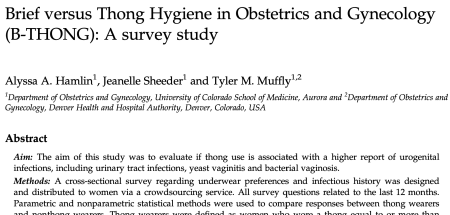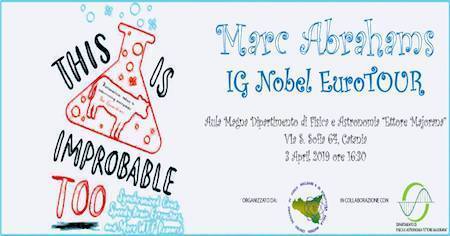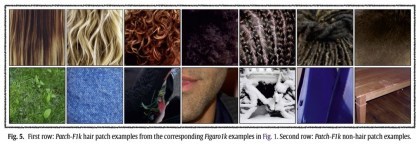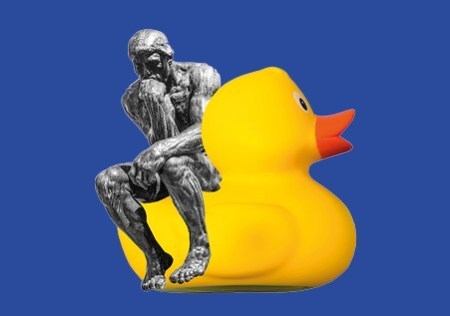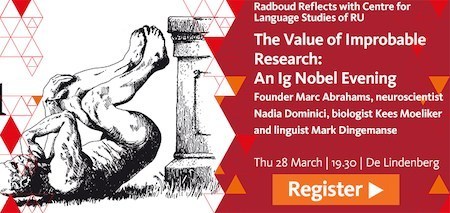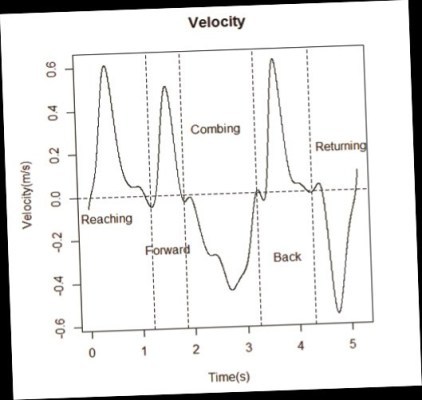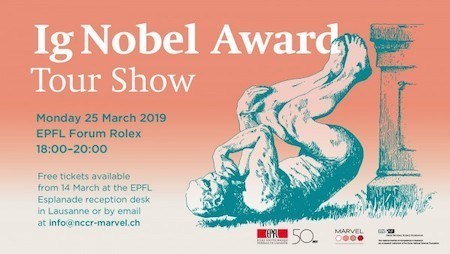Marc Abrahams's Blog, page 153
April 2, 2019
Brief versus Thong Hygiene in Obstetrics and Gynecology
Does thong underwear present heal hazards? A new study addresses certain aspects of that general question.
The study is “Brief versus Thong Hygiene in Obstetrics and Gynecology (B-THONG): A survey study,” Alyssa A. Hamlin, Jeanelle Sheeder, and Tyler M. Muffly, Obstestrics and Gynecology Research, vol., 131, May 2018, 108S ff. (Thanks to Gwinyai Masukume for bringing this to our attention.)
The authors, at the University of Colorado School of Medicine, Aurora and Denver Health and Hospital Authority, Denver, include data on:
Cleaning practices—
Wipe front to back
Wipe back to fr
They state this conclusion:
In this large cross-sectional study we found that oral sex was the only independent predictor of urinary tract infection and bacterial vaginosis, and that wearing noncotton crotch underwear was associated with yeast vaginitis. Wearing thong underwear was not associated with any urogenital infections. Medical providers should discuss sexual practices and underwear fabric, rather than style, with their patients when there is concern for urogenital infection.
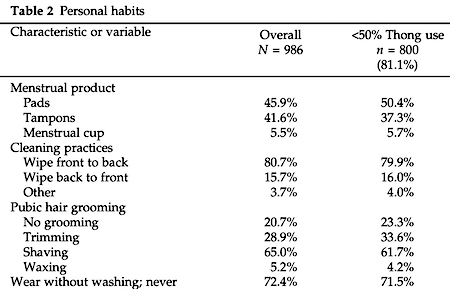
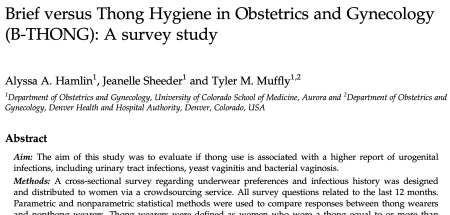

Ig Nobel afternoon in Sicily Wednesday
Wednesday afternoon, the Ig Nobel EuroTour arrives in Catania, Sicily—featuring random promotion, roller-coaster-induced kidney-stone-passing, homosexual necrophiliac ducks, and all sorts of other prize-winning things that make people LAUGH, then THINK.
April 3, Wednesday, 4:30 pm—University of Catania, Italy—at
CSFNSM – Centro Siciliano di Fisica Nucleare e Struttura della Materia, via S. Sofia 64— Marc Abrahams will talk about the Ig Nobel Prizes and Improbable Research. [PREVIEW] Confirmed rumor has it that the winners of the 2010 Ig Nobel prize for management will be at the event.
Tour Subsequent Events
After that, the Ig Nobel EuroTour will move on to Sweden, Norway, Germany, and Italy (again).

April 1, 2019
Straight, wavy, curly, kinky, braids, dreadlocks, and short hairstyles – computationally sorted [study]
“Hair detection in images is useful for many applications, such as face and gender recognition, video surveillance, and hair modelling.”
– prompting the development of a new Convolutional Neural Network (CNN) software application which can sort images of hair styles into straight, wavy, curly, kinky, braids, dreadlocks, and short – with an accuracy of around 90%.
The system for hair detection, segmentation, and hairstyle classification in the wild (that’s to say outside the lab) has been developed by researchers at the University of Brescia, Italy, Queen Mary University of London, and the University of Glasgow.
“Even if attitudes towards hairstyles or hair removal may vary widely across different cultures and historical periods, hairstyle is one of the defining characteristics of humans, often related to person’s social position, such as age, gender, religion. Despite the fact that human [sic] can drastically manipulate their hair, they typically do not, so that hair appearance and attributes may provide useful cues also for the recognition task. Hence, as another contribution, for the first time automatic hairstyle recognition is performed here by means of a multi-class texture classification step on the previously segmented hair region.”
See: Hair detection, segmentation, and hairstyle classification in the wild in Image and Vision Computing,Volume 71, March 2018, Pages 25-37.
BONUS The research team have created a Multi-class hair image database (straight, wavy, curly, kinky, braids, dreadlocks, and short-men) with Ground Truth, which is freely available for download here (42MB)

March 31, 2019
Ig Nobel Night in Warsaw Monday
Monday evening, the Ig Nobel EuroTour arrives in Warsaw—featuring homosexual necrophiliac ducks, and all sorts of other prize-winning things that make people LAUGH, then THINK. Despite this being April Fools day, everything will be real.
April 1, Monday, 6:00 pm—Copernicus Science Centre, Warsaw, Poland— Marc Abrahams and Ig Nobel Prize winner Kees Moeliker (Homosexual necrophilia in the mallard duck).
Tour Subsequent Events
After that, the Ig Nobel EuroTour will move on to Italy, Sweden, Norway, Germany, and Italy (again).

March 29, 2019
The day Ig Nobel people came together at Hokkaido University
This film documents what happened when I (founder of the Ig Nobel Prize ceremony) visited two Ig Nobel Prize winners at Hokkaido University.
Toshiyuki Nakagaki, winner (with his team) of two Ig Nobel Prizes (in 2008 for discovering that slime molds can solve puzzles, and in 2010 for using slime mold to determine the optimal routes for railroad tracks) and Kazunori Yoshizawa, winner in 2017 for the discovery of a female penis, and a male vagina, in a cave insect, were gracious hosts. Many of their colleagues and students joined in the mutual amusement.
Kiyoshi Furusawa and his colleagues tell the video story of my visit to the campus and especially to the two labs:
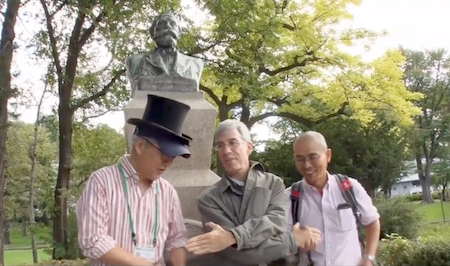
A second video shows what happened during the public event we held later that day with a group of happily rambunctious students:
This all happened in late September of 2018.
I was in Japan for the opening of the Ig Nobel Prizes exhibition at the Tokyo Dome complex. Professors Nakagaki and Yoshizawa—together with eight other Japanese Ig Nobel Prize winners—took part in the press opening of that event in (of course) Tokyo, as did some fifty-odd journalists. (Quick snippets of that day appear near the start of this video.)
The arrival of these Hokkaido videos comes at a happy time—in the middle of the 2019 Ig Nobel EuroTour, when scenes a little like these are happening in many of the ten European countries I’m visiting.

March 28, 2019
Placebos (can) work even when you don’t use them [new study]
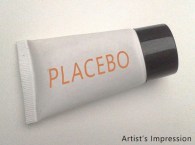 The mysterious workings of the Placebo Effect have taken a new twist. A research team from Lingnan University, Hong Kong, and The University of Toledo, US, have found, by experiment, that a placebo cream (that’s to say a faux medical cream with absolutely no active ingredients) can be quite effective even when it’s not used.
The mysterious workings of the Placebo Effect have taken a new twist. A research team from Lingnan University, Hong Kong, and The University of Toledo, US, have found, by experiment, that a placebo cream (that’s to say a faux medical cream with absolutely no active ingredients) can be quite effective even when it’s not used.
“We hypothesized that forming an association with a placebo analgesic, such as by acquiring the ownership, may elevate belief in one’s ability to cope with pain, thus resulting in greater pain reduction. Specifically, if individuals receive a placebo analgesic cream, they may experience less pain in a subsequent pain-perception test–even when they have not used the cream–compared to those who do not receive the cream.“
See: Merely Possessing a Placebo Analgesic Reduced Pain Intensity: Preliminary Findings from a Randomized Design in Current Psychology, February 2019, Volume 38, Issue 1, pp 194–203

March 27, 2019
Ig Nobel Night in Nijmegen Thursday!
Thursday evening, the Ig Nobel EuroTour arrives in Nijmegen—featuring homosexual necrophiliac ducks, and humans walking on water, and ‘Huh?’, and Kees and Nadia and Mark and Marc, and also Lisa:
March 28, Thursday, 7:30 pm—The Value of Improbable Research: An Ig Nobel Evening, Nijmegen, The Netherlands, at De Lindenberg, organized by Radboud University and the Centre for Language Studies of RU—TICKETS TICKETS TICKETS. Marc Abrahams and
Ig Nobel Prize winner Mark Dingemanse (The word “huh?” seems to exist in every human language)
Ig Nobel Prize winner Nadia Dominici (People can run across the surface of a pond, if that pond is on the moon)
Ig Nobel Prize winner Kees Moeliker (Homosexual necrophilia in the mallard duck)
A philosophical round of questioning led by Lisa Doeland
Tour Subsequent Events
After that, the Ig Nobel EuroTour will move on to Poland, Italy, Sweden, Norway, Germany, and Italy (again).

March 25, 2019
The peak velocity of elbow joints during hair-combing activities (study)
If you comb your hair, you may have found yourself wondering how fast (in metres per second) your elbow moves as you do so. In which case, help is at hand – in the form of a recent paper published in the American Institute of Physics (AIP) Conference Proceedings.
A research team from Kolej Poly-Tech MARA in Kuala Lumpur, found, by experiment, that it tends to be around 0.4 – 0.6 m/s.
See: Peak velocity of elbow joint during hair combing activity for normal subject in AIP Conference Proceedings 1940, 020113 (2018)

Ig Nobel in Lausanne tonight!
Tuesday evening, the Ig Nobel EuroTour arrives École Polytechnique Fédérale de Lausanne—featuring Cats and Locusts and Star Wars and ‘Huh?’ and Claire and Mark and Marc and Marc:
March 25, Monday, 6:00 pm—EPFL, Lausanne, Switzerland, in the Rolex Forum—This is part of EPFL’s 50th anniversary celebration! TICKETS TICKETS TICKETS. [PREVIEW]—Marc Abrahams and
Ig Nobel Prize winner Claire Rind (Monitoring a brain cell of a locust while that locust watches selected highlights from the movie Star Wars)
Ig Nobel Prize winner Marc Fardin (Can a cat be both a solid and a liquid?)
Ig Nobel Prize winner Mark Dingemanse (The word “huh?” seems to exist in every human language)
Tour Subsequent Events
After that, the Ig Nobel EuroTour will move on to The Netherlands, Poland, Italy, Sweden, Norway, Germany, and Italy (again).

March 21, 2019
Photographers walking backwards – and falling over (study)
It’s a staple gag for any slapstick movie. Trying for a wider shot, a photographer walks backwards (without looking) and trips over something. Amusing perhaps, but on occasions dangerous too. Odd then, that in the academic literature on safety and ergonomics, there a very few scholarly studies of this ubiquitous syndrome. In fact, there may only be one – in which certified professional ergonomist Dr. Kenneth Nemire, of California, set up a practical experiment to investigate.
Two researchers asked passers-by to photograph them, but then added a request that the building behind them was to be kept in-shot. A third (unseen) researcher was recording the events on video. Later, the videos were analysed to see how many steps the photographers took backwards, and whether they looked behind them*.
The research project revealed that although the majority of the 39 participants did glance behind them before walking backwards, a significant proportion (13%) of them didn’t. Not a high percentage perhaps, but bearing in mind the number of people across the globe taking snaps on any given day, that’s still a high number of potentially amusing (or maybe not so amusing) mishaps.
As Dr Nemire points out ; “Stepping backward without looking is as dangerous as walking forward while wearing a blindfold.”
Reference: Walking Backwards Without Looking: An Observational Study in Proceedings of the Human Factors and Ergonomics Society Annual Meeting, Volume: 56 issue: 1, page(s): 685-689, December 2016.
*No photographers were harmed during this study.

Marc Abrahams's Blog
- Marc Abrahams's profile
- 14 followers


